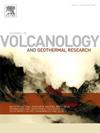克罗诺茨基火山——堪察加半岛的一个低钾端元锋面火山:地质构造和岩石矿物组成
IF 2.3
3区 地球科学
Q2 GEOSCIENCES, MULTIDISCIPLINARY
Journal of Volcanology and Geothermal Research
Pub Date : 2025-08-18
DOI:10.1016/j.jvolgeores.2025.108430
引用次数: 0
摘要
克罗诺茨基火山是堪察加弧锋面区最大的层状火山,但研究得很少。在这里,我们提供了关于这座火山的地质结构及其岩石和矿物组成的第一个系统数据。Kronotsky熔岩主要为低钾、高铁拉斑玄武岩至玄武岩安山岩,SiO2 = 47.0 ~ 53.2 wt%, K2O = 0.24 ~ 0.65 wt%, FeO δ = 9.1 ~ 13.4 wt%, MgO = 3.7 ~ 11.2 wt%。安山岩(SiO2 = 59.9 ~ 60.5 wt%, K2O = 0.65 wt%, FeO = 7.7 ~ 7.6 wt%, MgO = 2.4 ~ 2.6 wt%)较为罕见,产于岩浆锥和岩浆颈之间。Kronotsky玄武岩的主要斑晶为橄榄石(fo91.9 ~ 67)、斜长石(an95 ~ 40)和高钙辉石(Mg#89.3 ~ 50)。正辉石在安山岩中以斑晶(Mg# 61-67)的形式出现,在玄武岩安山岩中很少出现,在大多数基性玄武岩品种的高钙辉石肾小球晶体中以包裹体(Mg#83)的形式出现。钛磁铁矿(Fe2+/Fe3+ = 0.98 ~ 1.51, TiO2 = 11.0 ~ 16.5 wt%)在玄武岩的安山岩和微岩中形成亚斑晶。在橄榄石斑晶中发现Cr尖晶石包裹体(Cr/Cr + Al = 0.19 ~ 0.79, TiO2 = 0.18 ~ 2.81 wt%, Al2O3 = 8.7 ~ 33.2 wt%)。整体岩石和矿物组成的变化反映了火山下存在寿命较长的岩浆房,以及在上升和减压过程中与岩浆脱气有关的晶体分化、聚集和岩浆混合以及结晶过程。与堪察加地区所有第四纪火山相比,Kronotsky玄武岩的K2O(低至0.24 wt%)和其他一些不相容元素(Ti、Zr、Nb、LREE)的富集程度最高,其Nb/Zr(≤0.02)和Nb/Yb(≤0.5)的比值最低。与堪察加其他火山相比,其Ba/Nb(高达280),尤其是Ba/Th(高达938)的比值相对较高。高mg橄榄石(Fo≥87.5 mol%, Ni≤2500 ppm, Fe/Mn = 56 ~ 71)组成表明,Kronotsky火山原生岩浆来源于橄榄岩幔源。微量元素模拟表明,该地幔高度熔融(高达25%),并且比典型MORB和堪察加地区大多数母岩浆的来源更枯竭。异常高的熔融程度,加上流体流动元素的相对富集,表明来自克罗诺茨基火山下俯冲太平洋板块的流体通量增强,这是地幔广泛熔融的原因。太平洋板块上的Krusenstern断裂带俯冲于堪察加中部下方,可能为Kronotsky火山下方的地幔楔提供了丰富的含水流体,使其在堪察加弧内具有独特的特征。本文章由计算机程序翻译,如有差异,请以英文原文为准。
Kronotsky Volcano – A low-K end-member frontal volcano in Kamchatka: Geological structure and composition of rocks and minerals
Kronotsky volcano is the largest but poorly studied stratovolcano in the frontal zone of the Kamchatka arc. Here we present the first systematic data on the geological structure of this volcano and the composition of its rocks and minerals. Kronotsky lavas are predominantly low-K, high-Fe tholeiitic basalts to basaltic andesites with SiO2 = 47.0–53.2 wt%, K2O = 0.24–0.65 wt%, FeO⁎ = 9.1–13.4 wt% and MgO = 3.7–11.2 wt%. Andesites (SiO2 = 59.9–60.5 wt%, K2O = 0.65 wt%, FeO⁎ = 7.7–7.6 wt%, MgO = 2.4–2.6 wt%) are rare and occur among the lava cones and necks from the latest stage of activity. The major phenocrysts in Kronotsky basalts are olivine (Fo91.9–67), plagioclase (An95–40) and high-Ca pyroxene (Mg#89.3–50). Orthopyroxene occurs as phenocrysts (Mg#61–67) in the andesites and rarely in the basaltic andesites, and as inclusions (Mg#83) in the high Ca-pyroxene glomerocrysts of the most mafic varieties of basalts. Ti-magnetite (Fe2+/Fe3+ = 0.98–1.51, TiO2 = 11.0–16.5 wt%) forms subphenocrysts in andesites and microlites in the groundmass of basalts. Inclusions of Cr-spinel (Cr/Cr + Al = 0.19–0.79, TiO2 = 0.18–2.81 wt% and Al2O3 = 8.7–33.2 wt%) are found in olivine phenocrysts. Variations of whole rock and mineral compositions reflect the existence of long-lived magma chamber(s) under the volcano and the processes of crystal differentiation, accumulation and magma mixing as well as crystallization associated with magma degassing during ascent and decompression.
Compared to all Quaternary volcanoes on Kamchatka, Kronotsky basalts are the most depleted in K2O (down to 0.24 wt%) and a number of other incompatible elements (Ti, Zr, Nb, LREE), and are characterized by the lowest Nb/Zr (≤0.02) and Nb/Yb (≤0.5) ratios. In contrast, Ba/Nb (up to 280) and especially Ba/Th (up to 938) ratios are relatively high compared to other Kamchatka volcanoes. The composition of high-Mg olivine (Fo ≥ 87.5 mol%, Ni ≤2500 ppm, Fe/Mn = 56–71) indicates that the primary magmas of Kronotsky volcano originated from a peridotite mantle source. Trace element modeling suggests that the mantle was melted to a high degree (up to 25 %) and was more depleted than the source of typical MORB and of most parental magmas in Kamchatka. The exceptionally high degree of melting, combined with a strong relative enrichment in fluid mobile elements, suggests an enhanced fluid flux from the subducting Pacific plate beneath Kronotsky volcano, which is responsible for the extensive mantle melting. The Krusenstern fracture zone on the Pacific plate, subducting beneath central Kamchatka, may supply abundant hydrous fluids to the mantle wedge beneath Kronotsky volcano, contributing to its distinctive character within the Kamchatka arc.
求助全文
通过发布文献求助,成功后即可免费获取论文全文。
去求助
来源期刊
CiteScore
5.90
自引率
13.80%
发文量
183
审稿时长
19.7 weeks
期刊介绍:
An international research journal with focus on volcanic and geothermal processes and their impact on the environment and society.
Submission of papers covering the following aspects of volcanology and geothermal research are encouraged:
(1) Geological aspects of volcanic systems: volcano stratigraphy, structure and tectonic influence; eruptive history; evolution of volcanic landforms; eruption style and progress; dispersal patterns of lava and ash; analysis of real-time eruption observations.
(2) Geochemical and petrological aspects of volcanic rocks: magma genesis and evolution; crystallization; volatile compositions, solubility, and degassing; volcanic petrography and textural analysis.
(3) Hydrology, geochemistry and measurement of volcanic and hydrothermal fluids: volcanic gas emissions; fumaroles and springs; crater lakes; hydrothermal mineralization.
(4) Geophysical aspects of volcanic systems: physical properties of volcanic rocks and magmas; heat flow studies; volcano seismology, geodesy and remote sensing.
(5) Computational modeling and experimental simulation of magmatic and hydrothermal processes: eruption dynamics; magma transport and storage; plume dynamics and ash dispersal; lava flow dynamics; hydrothermal fluid flow; thermodynamics of aqueous fluids and melts.
(6) Volcano hazard and risk research: hazard zonation methodology, development of forecasting tools; assessment techniques for vulnerability and impact.

 求助内容:
求助内容: 应助结果提醒方式:
应助结果提醒方式:


